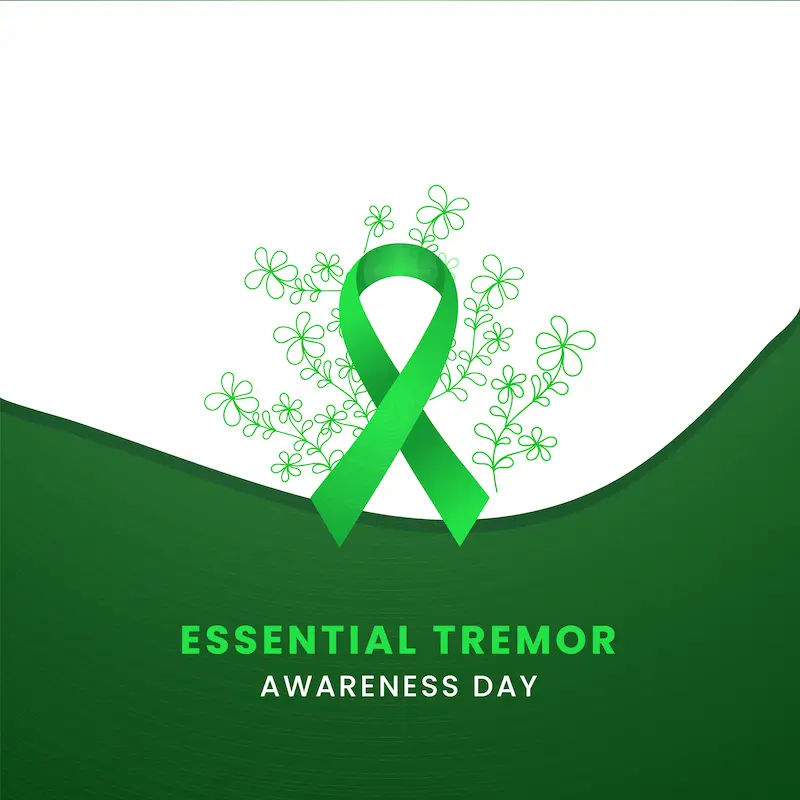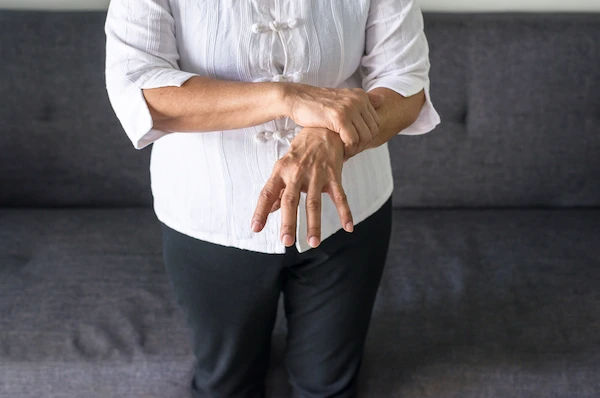Guide to Explained Common Types Tremors
Discover the different types of tremors, from essential to Parkinsonian, with this comprehensive guide. Learn about the causes, symptoms, and treatment options for each to better understand your condition.

Written by Dr. M L Ezhilarasan
Reviewed by Dr. Mohammed Kamran MBBS, FIDM
Last updated on 30th Sep, 2025
.webp?tr=q-80,f-webp,w-350,dpr-2,c-at_max 700w)
Introduction
Have you ever reached for a cup of coffee and noticed your hand shaking slightly? Or perhaps you've felt a subtle quiver in your leg while sitting still? While often harmless, tremors—the involuntary, rhythmic shaking of a body part—can be a source of anxiety and confusion. Understanding the different types of tremors is crucial because not all shaking is the same. A tremor can be a temporary reaction to stress or caffeine, or it can be a symptom of an underlying neurological condition. This guide is designed to demystify this common symptom. We will walk you through the various tremor classifications, from the ubiquitous essential tremor to the distinctive resting tremor associated with Parkinson's disease. By the end, you'll have a clearer understanding of what might be causing unexplained shaking, when it's a cause for concern, and the importance of seeking professional medical advice for a proper diagnosis.
What is a Tremor? More Than Just Shaking
A tremor is an involuntary, rhythmic, oscillatory movement of a body part. It results from contractions of opposing muscle groups. Think of it as a miscommunication in the complex neurological pathways that control muscle movement. This isn't a sign of weakness; it's an issue of coordination within the central nervous system.
The Basic Mechanism: Why Your Body Trembles
Your brain acts as a command center, sending signals through the spinal cord to your muscles to initiate and control movement. This process involves a delicate balance of neurotransmitters and feedback loops between different brain regions, primarily the thalamus, cerebellum, and basal ganglia. When there's a disruption in this system—be it from fatigue, a chemical imbalance, or neurological damage—the result can be the uncontrolled, rhythmic firing of neurons that manifests as a tremor.
Classifying Tremors: At Rest vs. In Action
The most fundamental way doctors categorize tremors is based on when they occur. This simple distinction is often the first major clue in reaching a diagnosis.
Resting Tremors: Shaking When Muscles are Relaxed
As the name implies, a resting tremor is present when a muscle is completely at rest and supported against gravity. For example, your hands might shake while resting in your lap or while your arms are dangling at your sides. The tremor typically diminishes or disappears when you voluntarily move the limb. This type of tremor is strongly associated with Parkinson's disease.
Action Tremors: Shaking During Movement
Action tremors occur during any voluntary muscle contraction. They are further divided into several subtypes:
- Postural Tremor: Holding a Position. This tremor appears when you are holding a position against gravity, like extending your arms out in front of you. Essential tremor is a classic example of a postural tremor.
- Kinetic Tremor: The Tremor of Motion. This is triggered by any voluntary movement, such as moving your wrist up and down.
- Intention Tremor: The Cerebellum's Signature. This is a specific type of kinetic tremor that worsens as you approach a target. A common test is the "finger-to-nose test," where the shaking becomes more pronounced as the finger gets closer to the nose. This is a key sign of issues with the cerebellum, the part of the brain responsible for coordination.
Consult Top Specialists
A Deep Dive into the Most Common Tremor Types
Essential Tremor: The Most Common Neurological Movement Disorder
Affecting millions worldwide, Essential Tremor (ET) is often misunderstood as a symptom of Parkinson's. However, it's a distinct condition. It's often hereditary, with about half of all cases having a family history.
- Key Characteristics of Essential Tremor: ET is primarily a postural and kinetic tremor. It most commonly affects the hands, but can also involve the head (causing a "yes-yes" or "no-no" motion), voice, and less commonly, the legs. It's often called an "action tremor" because it's most evident when doing tasks like drinking from a glass, using a spoon, or writing. A key differentiator is that alcohol consumption temporarily reduces tremors in many people with ET, which is not the case with Parkinsonian tremors.
Parkinsonian Tremor: The "Pill-Rolling" Shake
This is the hallmark tremor of Parkinson's disease. It's primarily a resting tremor. The classic presentation is a "pill-rolling" tremor of the hand, where the thumb and forefinger rub together in a circular motion. It usually starts asymmetrically (on one side of the body) and is often accompanied by other symptoms like slowness of movement (bradykinesia), stiffness, and balance problems.
- Distinguishing Parkinsonian from Essential :Tremor The core difference lies in the state of activity. Parkinsonian tremor is worst at rest; Essential Tremor is worst during action. If your shaking is most noticeable to others when you're trying to hold a newspaper (ET) versus when your hands are resting on the arms of a chair (Parkinson's), that's a critical observation.
Dystonic Tremor: Irregular Shaking from Muscle Contractions
This tremor occurs in people with dystonia, a movement disorder characterized by sustained or intermittent muscle contractions causing abnormal postures. The tremor itself is often irregular and can be relieved by touching the affected body part. For example, a person with a dystonic head tremor might find that gently resting a finger on their chin can reduce the shaking.
Cerebellar Tremor: Caused by Damage to the Brain's Coordination Center
As mentioned earlier, this is an intentional tremor. It is slow, broad, and worsens significantly at the end of a purposeful movement. Common causes include stroke, multiple sclerosis (MS), tumors, or alcoholism that has damaged the cerebellum.
Physiologic Tremor: The Shaking Everyone Has
This is a normal, very low-amplitude tremor that is present in every healthy individual. It's so fine that it's usually invisible to the naked eye. It's caused by physiological factors like the heartbeat, motor neuron firing rates, and feedback loops within the nervous system.
When Normal Tremor Becomes Enhanced: Certain triggers can amplify this normal tremor, making it visible. This is known as enhanced physiologic tremor. Common causes include:
- Stress, anxiety, or fear
- Fatigue
- Caffeine consumption
- Low blood sugar (hypoglycemia)
- Alcohol withdrawal
- Certain medications (e.g., asthma medications, corticosteroids, some antidepressants)
Other Notable Tremor Causes and Types
Psychogenic Tremor (Functional Tremor)
This tremor can vary significantly in its characteristics. It may start suddenly, change in direction or body part affected, and lessen when the person is distracted. It is associated with underlying psychological factors.
Orthostatic Tremor: Shaking Upon Standing
This is a rare, high-frequency tremor that occurs exclusively in the legs and trunk immediately upon standing. The person feels unsteady and has an intense urge to sit or walk. The tremor stops as soon as they sit down.
Key Differences at a Glance: A Comparative Table
| Tremor Type | When It Occurs | Most Affected Area | Key Characteristics |improve with alcohol. |
| Parkinsonian Tremor | Rest | Hands, Legs, Chin | "Pill-rolling" motion; often asymmetric. |
| Cerebellar Tremor | Intention (end of movement) | Limbs | Slow, broad; caused by cerebellum damage. |
| Enhanced Physiologic | Postural | Hands | Fine shake; triggered by stress, caffeine, etc. |
| Dystonic Tremor | Can be variable | Any body part | Irregular; associated with abnormal postures. |
When to See a Doctor: Recognizing the Red Flags
While occasional shaking from stress or fatigue is normal, you should consult a healthcare professional if:
- The tremor begins suddenly.
- It interferes with daily activities like writing, eating, or working.
- It is worsening over time.
- It is accompanied by other symptoms like muscle stiffness, slow movement, changes in speech, or balance problems.
- It causes you significant distress or anxiety.
A doctor can perform a neurological examination to assess the tremor's location, frequency, and amplitude. If your tremor is persistent or impacting your quality of life, consulting a neurologist online with Apollo24|7 can be a convenient first step for a professional evaluation. They can help determine if further investigation, such as imaging or lab tests, is needed.
Quick Takeaways:
- Not all tremors are Parkinson's: Essential Tremor is actually more common.
- The key question is "When?": Is the tremor present at rest or during action? This is the primary diagnostic clue.
- Enhanced physiologic tremor is very common: Stress, caffeine, and lack of sleep are frequent culprits for noticeable shaking.
- Family history matters: Essential Tremor often runs in families.
- Other symptoms are important: Tremor accompanied by stiffness or slow movement points toward Parkinson's disease.
- Diagnosis is clinical: A doctor's examination is the primary tool for diagnosis.
- Treatment is available: From lifestyle changes to medication and therapy, many tremors can be effectively managed.
Conclusion
Tremors can range from a minor nuisance to a sign of a more significant health issue. By understanding the common types—from the action-oriented Essential Tremor to the resting tremor of Parkinson's—you are better equipped to observe your own symptoms and have an informed conversation with a healthcare provider. Remember, a tremor is a symptom, not a diagnosis in itself. Identifying its pattern, triggers, and associated features is the pathway to effective management. If you are concerned about any unexplained shaking, don't hesitate to seek medical advice. A proper diagnosis is the essential first step toward finding the right treatment and improving your quality of life. For persistent symptoms, booking a physical visit to a neurologist with Apollo24|7 can provide a comprehensive assessment.
Consult Top Specialists
Consult Top Specialists

Dr. Rajib Ghose
General Physician/ Internal Medicine Specialist
25 Years • MBBS
East Midnapore
VIVEKANANDA SEBA SADAN, East Midnapore

Dr Vinay Kumar A V
Nephrologist
8 Years • MBBS, MD - General Medicine, DM - Nephrology
Bilaspur
Apollo Hospitals Seepat Road, Bilaspur
Dr Prachi Sankhe
General Physician/ Internal Medicine Specialist
8 Years • MBBS, MD (Internal Medicine)
Mumbai
Apollo Hospitals CBD Belapur, Mumbai
Dr. Indrajit Das
General Physician/ Internal Medicine Specialist
4 Years • "MD (Internal medicine) : Gauhati Medical College and Hospital, Guwahati (2018-2021) MD (Pathology) : Gauhati Medical College and Hospital, Guwahati (2012-2015) MBBS (Bachelor of Medicine, Bachelor of Surgery) : Silchar Medical College, Assam (2003-2008) "
Guwahati
Apollo Excelcare Hospital, Guwahati

Dr. Hariprasath J
General Physician/ Internal Medicine Specialist
19 Years • MD (Gen Med), FCCP, Dip (Diabetology, UK)
Chennai
Apollo First Med Hospitals P H Road, Chennai
(200+ Patients)
Consult Top Specialists

Dr. Rajib Ghose
General Physician/ Internal Medicine Specialist
25 Years • MBBS
East Midnapore
VIVEKANANDA SEBA SADAN, East Midnapore

Dr Vinay Kumar A V
Nephrologist
8 Years • MBBS, MD - General Medicine, DM - Nephrology
Bilaspur
Apollo Hospitals Seepat Road, Bilaspur
Dr Prachi Sankhe
General Physician/ Internal Medicine Specialist
8 Years • MBBS, MD (Internal Medicine)
Mumbai
Apollo Hospitals CBD Belapur, Mumbai
Dr. Indrajit Das
General Physician/ Internal Medicine Specialist
4 Years • "MD (Internal medicine) : Gauhati Medical College and Hospital, Guwahati (2018-2021) MD (Pathology) : Gauhati Medical College and Hospital, Guwahati (2012-2015) MBBS (Bachelor of Medicine, Bachelor of Surgery) : Silchar Medical College, Assam (2003-2008) "
Guwahati
Apollo Excelcare Hospital, Guwahati

Dr. Hariprasath J
General Physician/ Internal Medicine Specialist
19 Years • MD (Gen Med), FCCP, Dip (Diabetology, UK)
Chennai
Apollo First Med Hospitals P H Road, Chennai
(200+ Patients)
More articles from Tremor
Frequently Asked Questions
Can anxiety cause tremors?
Yes, absolutely. Anxiety is a very common cause of enhanced physiologic tremor. The stress response releases adrenaline, which can amplify the normal, fine shaking everyone has, making it visibly noticeable in the hands, voice, or other body parts.
What is the difference between essential tremor and Parkinson's disease?
The core difference is when the tremor occurs. Essential Tremor is an action tremor (worst when moving). Parkinson's tremor is a resting tremor (worst when the limb is relaxed). Parkinson's is also accompanied by other symptoms like slowness, stiffness, and balance issues, which are not typical of ET.
Are there any natural ways to reduce hand tremors?
For mild tremors, especially enhanced physiologic tremors, strategies can include reducing caffeine intake, managing stress through techniques like meditation or yoga, ensuring adequate sleep, and avoiding other known triggers. For diagnosed conditions like Essential Tremor, these methods may help but often need to be combined with medical treatment.
Can a vitamin deficiency cause tremors?
Yes, deficiencies in certain vitamins, particularly B12, B1 (thiamine), and magnesium, can sometimes lead to neurological symptoms, including tremors. If a deficiency is suspected, a doctor may recommend blood tests. Apollo24|7 offers convenient home collection for tests like vitamin panels to help identify such deficiencies.
When is a head tremor a sign of something serious?
While a head tremor can be a benign sign of Essential Tremor (especially if it's a 'no-no' or 'yes-yes' motion), a new or worsening head tremor should always be evaluated by a doctor. It could be related to cervical dystonia or other neurological conditions that require specific treatment.


.webp)